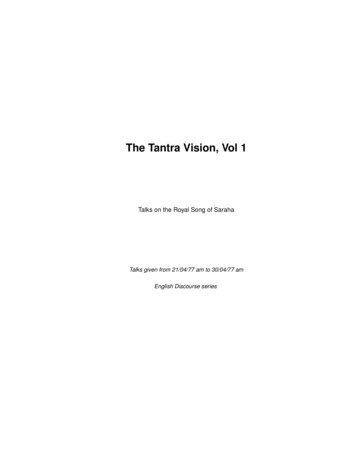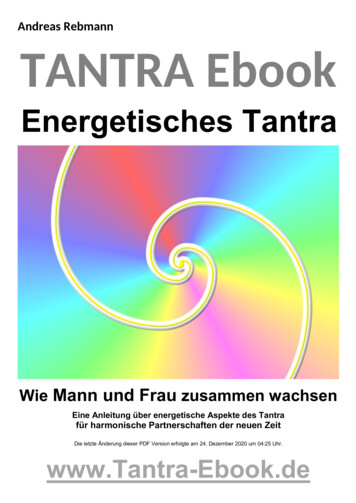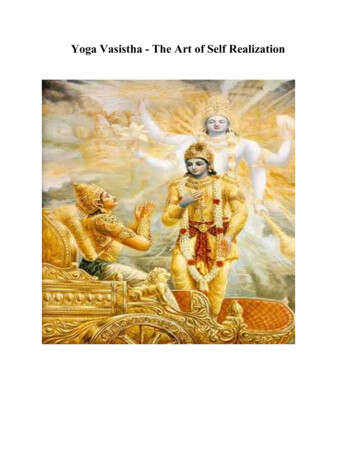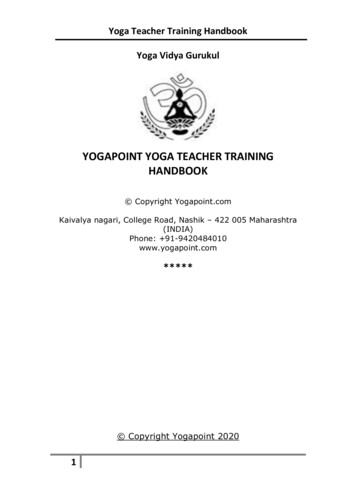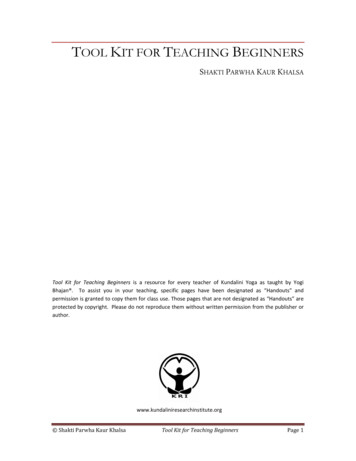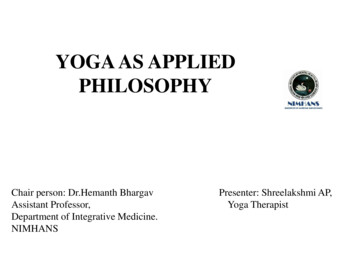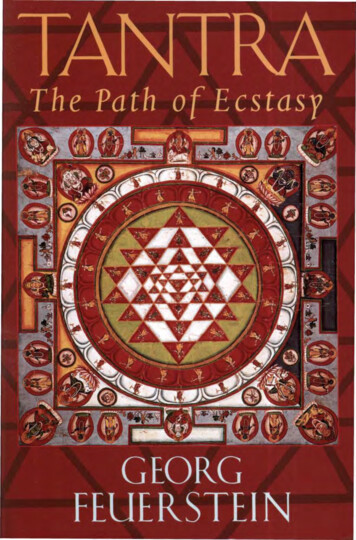
Transcription
EASTERNPHILOSOPHY"Georg Fcuerstein, who is arguably today's foremost Yoga researcher, hasgiven us yet another very valuable book. Tantra: The Art of Ecstasy is the firstnonacademic but sound and well-rounded introduction to the HinduTantric heritage since Sir John Woodroffe's pioneering publications of the1920s. It corrects many widespread misconceptions and shows Tantrism tobe a complex and intriguing tradition that deserves deeper study. Recommended reading for all students of Hinduism, Yoga, and spirituality ingeneral."-—PROF. SUBHASH KAK, P H . D . , author of India at Century's Endand coauthor of In Search of the Cradle of CivilizationTantra—often associated with KundaliniYoga—is a fundamental dimension of Hinduism, emphasizing the cultivation of "divine power" (shakti) asa path to infinite bliss. Tantra has been widely misunderstood in the West,however, where its practices are often confused with eroticism and licentious morality. Tantra:The Path of Ecstasy dispels many c o m m o n misconceptions, providing an accessible introduction to the history, philosophy, andpractice of this extraordinary spiritual tradition.The Tantric teachings are geared toward the attainment of enlightenment as well as spiritual power and are present not only in Hinduismbut also Jainism and Vajrayana Buddhism. In this book, Georg Feuersteinoffers readers a clear understanding of authentic Tantra, as well as appropriate guidance for spiritual practice and the attainment of higherconsciousness.G E O R G FEUERSTEIN, P H . D . , holds degrees in Indology and thehistory of religion. In addition to being the director of the Yoga ResearchCenter, he is a contributing editor of Yoga Journal, Inner Directions, andIntuition. He has authored thirty books, including The Shambhala Encyclopedia of Yoga and Teachings of Yoga.Cover art: A Shri yantra, Nepal, seventeenth century. From Tantra: The Indian Cult of Ecstasy, by PhilipRawson, published by Thames and Hudson, Inc., New York.Photograph by John Webb. Reproduced courtesy of Thames and Hudson. 1998 Shambhala Publications, Inc. Printed in U.S.A.SHAMBHALABoston & London
Tantra
BOOKSGEORGB YFEUERSTEINThe Deeper Dimension of Yoga: Theory and Practice ( 2 0 0 3 ) *The Shambhala Encyclopedia of Yoga ( 2 0 0 0 ) *Tantra: The Path of Ecstasy ( 1 9 9 8 ) *Teachings of Yoga ( 1 9 9 7 ) *Lucid Waking (1997)The Shambhala Guide to Yoga ( 1 9 9 6 ) *In Search of the Cradle of Civilization,coauthored with Subhash Kak and David Frawley (1995)The Mystery of Light (1994)Voices on the Threshold of Tomorrow,coedited with Trisha Lamb Feuerstein (1993)Sacred Sexuality (1993)Living Yoga, coedited with Stephan Bodian (1993)Wholeness or Transcendence? (1992)Sacred Paths (1991)The Yoga-Sutra of Patanjali (1990)The Bhagavad-Gita: Its Philosophy and Cultural Setting (1983)The Essence of Yoga (1976)* Published by Shambhala Publications
TantraTHEOFPATHECSTASYGeorg FeuersteinSHAMBBoston & LondonHALA1998
Shambhala Publications, Inc.Horticultural Hall300 Massachusetts AvenueBoston, Massachusetts 02115www.shambhala.com 1998 by Georg FeuersteinThe author thanks Princeton University Press for permission to quote fromReligions of India in Practice, D. S. Lopez, Jr., ed., copyright 1995 by PrincetonUniversity Press.All rights reserved. No part of this book may bereproduced in any form or by any means, electronic ormechanical, including photocopying, recording, or by anyinformation storage and retrieval system, withoutpermission in writing from the publisher.17161514131211109Printed in the United States of America This edition is printed on acid-free paper that meets theAmerican National Standards Institute Z39.48 Standard.Distributed in the United States by Random House, Inc.,and in Canada by Random House of Canada LtdLibrary of Congress Cataloging-in-Publication DataFeuerstein, Georg.Tantra: the path of ecstasy: an introduction to Hindu tantrism /by Georg Feuerstein.p. cm.Includes bibliographical references and index.ISBN 978-1-57062-304-2 (pbk.)1. Tantrism. I. Tide.BL1283.84.F47199897-29983294.5'514—dc21CIP
This book is dedicated to my kalyana-mitra LamaSegyu Choepel, who opened my eyes to the realitybehind Tantra in the form of Vajrayana Buddhism,and to the memory of the great masters of the Tantrictradition whose potent liberation teachings have, for centuryafter century to the present time, been a bright lamp illumining the steps of seekers in the trouble-filled Age of Darkness.May modem seekers, pure in intent, walk safely andswiftly on the path of self transformation and discoverthe unsurpassable bliss of Reality, free from all concern,in their own hearts and in the hearts of all others.
tualSynthesisof India11 Samsara: Cyclic Existence20232Time, Bondage, and the Goddess Kali3This Is the O t h e r World: Samsara Equals Nirvana4TheSecret of Embodiment:AsAbove,So42Below525T h e Divine Play of Shiva and Shakti706The Guru Principle: Shiva Incarnate857Initiation: Bringing D o w n the Light8Discipleship:9The Tantric Path: Ritual and 0 The Subtle Body and Its Environment13911Awakening the Serpent Power16512Mantra: T h e Potency of Sound18413Creating Sacred Space: Nyasa, Mudra, Yantra20114The Transmutation of Desire22415 Enlightenment and the H i d d e n Powers of the Mind250Epilogue: Tantra Yesterday, Today, and Tomorrow268Notes275Select Bibliography295Index301About the Author315.
PrefaceI worship in my heart the Goddesswhose body is awash with ambrosia,beautiful like lightning, who, going from her abodeto Shiva's royal palace, opens the lotusesof the lovely axial channel (sushumna).— Bhairavi-Stotra (12)"Tantra" has become a household word in certain circles in the West.But, as is often the case with household words, popularity does notnecessarily imply understanding. Frequently we hear words like "consciousness," "holistic," "creativity," or "imagination," but how manypeople could give an intelligent explanation of any of these? Similarly,Tantra has captured the fascination of a good many Westerners, butfew of them actually know what it stands for, including some of thosewho profess to practice, teach, or write about it.Tantra, or Tantrism, is an exceptionally ramified and complexesoteric tradition of Indic origin. It made its appearance around 500
xPrefaceCE, though some of its proponents claim a far longer history. Tantralike ideas and practices can indeed be found in traditions and teachings of a much earlier era. As a full-fledged movement or culturalstyle extending over both Hinduism and Buddhism, however, Tantraseems to have originated around the middle of the first millenniumCE. It reached maturity around 1000 CE in the philosophical schoolof Abhinava Gupta. It profoundly influenced the outlook and practicesof many non-Tantric traditions, such as Vedanta. Often practitionersof those traditions have been unaware of that influence and mighteven be offended at the suggestion that they engage in typically Tantricpractices.The reason for this is that within the fold of Hinduism, Tantragradually fell into disrepute because of the radical antinomian practices of some of its adherents. During the Victorian colonization ofIndia, puritanism drove Tantric practitioners underground. TodayTantra survives mainly in the conservative (samaya) molds of the ShrlVidya tradition of South India and the Buddhist tradition of Tibet,though both heritages also have their more radical practitioners whounderstandably prefer to stay out of the public limelight. ParticularlyTibetan Vajrayana has become increasingly popular in the West, andit is relatively easy to receive initiation and instruction in this form ofTantra.From the beginning, Tantra understood itself as a "new age"teaching especially tailored for the needs of the kali-yuga, the era ofspiritual decline that is still in progress today. According to HerbertV. Guenther, a renowned scholar of Buddhism, the Tantras - the scriptures of Tantrism - "contain a very sound and healthy view of life." 1His implied point, that the Tantric view is valid and pertinent eventoday, matches the appraisal of other Western scholars and studentsof Tantra. Robert Beer, a color-blind British painter of beautiful,richly colored thankas, remarked that the psychological core of thenumerous Tantric legends "has a universal appeal and application thattranscends culture, religion, and race." 2 I would go further and saythat many facets of Tantric psychology and practice are relevant to all
Prefacexiwho seek to cultivate self-understanding and are sincerely engaged inthe noble task of spiritual self-transformation.From the outset, Tantra has straddled both Hinduism and Buddhism, and Tantra-style teachings can be found even in the Indicminority religion of Jainism. Hindu Tantra, which I will somewhatarbitrarily call "Tantra Yoga" to distinguish it from the Buddhist andJaina varieties, was introduced to the Western world through the writings of Sir John Woodroffe. His English rendering of the famousMahanirvana-Tantra was published in 1913 and was followed a fewyears later by his books Shakti and Shakta and The Serpent Power.3, Atthat time it was still considered odious for a scholar to study theTantric tradition, which was deemed the most decadent manifestationof Hindu culture. Woodroffe, a high-court judge in Calcutta, brokeall the rules when he put on Indian garb and sat at the feet of Hindupundits well versed in Tantra. As he once said:I have often been asked why I had undertaken the study ofthe Tantra Sastra, and in some English (as opposed to Continental) quarters it has been suggested that my time and labourmight be more worthily employed. One answer is this: Following the track of unmeasured abuse I have always found something good. The present case is no exception. I protest and havealways protested against unjust aspersions upon the Civilizationof India and its peoples. . . . I found that the Sastra was of highimportance in the history of Indian religion. The Tantra Sastraor Agama is not, as some seem to suppose, a petty Sastra of noaccount; one, and an unimportant sample, of the multitudinousmanifestations of religion in a country which swarms with everyform of religious sect. It is on the contrary with Veda, Smrti andPurana one of the foremost important Sastras in India, governing, in various degrees and ways, the temple and household ritual of the whole of India today and for centuries past. . . . Overand above the fact that the Sastra is an historical fact, itpossesses, in some respects, an intrinsic value which justifies itsstudy. Thus it is the storehouse of Indian occultism. This occultside of the Tantras is of scientific importance, the more particularly having regard to the present revived interest in occultiststudy in the West.4
xiiPrefaceThese words, written eight decades ago, are relevant today forthe same reasons.5 In the succeeding years a few other Western scholars, for the most part still feeling apologetic about their research, havefollowed in the footsteps of this intrepid pioneer. Even today, however, Hindu Tantra Yoga is only poorly researched, and most of itshigh teachings, which require direct experience or at least the explanations of an initiate, remain unlocked.The situation is strikingly different with the teachings of Buddhist Tantra, in the form of the Tibetan tradition of Vajrayana (Diamond Vehicle). Ever since the Chinese invasion of Tibet in 1950 andparticularly since the escape of His Holiness the Dalai Lama in 1959,Tibetan lamas have been generously teaching and initiating Westernpractitioners into all schools and levels of Vajrayana Buddhism. Topreserve their teachings in exile, many high lamas have consented towork closely with Western scholars on accurate translations of theTibetan Tantras and on explanatory monographs. Today, therefore, theBuddhist branch of Tantrism is not only more widely disseminatedthan the Hindu branch but also better understood in the West thanits Hindu counterpart.The many excellent books on Buddhist Tantra give one a realappreciation of the tremendous sophistication of this tradition.6 Goodworks on Hindu Tantra Yoga, however, are few, and the books byWoodroffe, though dated and incorrect in places, are still exemplaryin many respects. The Hindus never had the kind of extensive monastic tradition of learning and practice that characterizes the Buddhists,particularly the Tibetan Gelugpa school. It is difficult (though notimpossible) to find a Hindu Tantric adept who not only has masteredthe practical dimension of Tantra Yoga but also can talk knowledgeably about the theoretical aspects. Western scholars are therefore naturally drawn to the study of Buddhist Tantra. A notable exceptionwas the late Swami Lakshmanjoo (1907 - 94), an adept and masterexpounder of the Kaula tradition of Kashmir, who inspired manyWestern scholars and Hindu pundits.7 Many of Swami Lakshmanjoo'sdisciples think of him as the reincarnation of the famous tenthcentury adept and scholar Abhinava Gupta.
xiiiPrefaceSwami Lakshmanjoo (1907 - 94), a master of both thetheoretical and practical dimensions of Hindu Tantra.(PHOTOGRAPH BY J O H N HUGHES COPYRIGHT KASHMIRSHAIVISM FELLOWSHIP)The paucity of research and publications on the Tantric heritageof Hinduism has in recent years made room for a whole crop of illinformed popular books on what I have called "Neo-Tantrism." 8Their reductionism is so extreme that a true initiate would barelyrecognize the Tantric heritage in these writings. The most commondistortion is to present Tantra Yoga as a mere discipline of ritualizedor sacred sex. In the popular mind, Tantra has become equivalent tosex. Nothing could be farther from the truth!I have looked at a number of these popular books on what onewell-known Tibetan lama once jokingly referred to as "California Tan-
XIVPrefacetra." One time I even sat through half of a thoroughly uninspiringand essentially pornographic video presentation on Neo-Tantrism. Ineach case I was left with the overwhelming impression that theseNeo-Tantric publications are based on a profound misunderstandingof the Tantric path. Their main error is to confuse Tantric bliss (ananda, maha-sukha) with ordinary orgasmic pleasure. Indeed, the words"pleasure" and "fun" are prominent catchphrases in the Neo-Tantricliterature. These publications may conceivably be helpful to peoplelooking for a more fulfilling or entertaining sex life, but they are inmost cases far removed from the true spirit of Tantra. In this sensethey are sadly misleading, for instead of awakening a person's impulseto attain enlightenment for the benefit of all beings, they tend tofoster narcissism, self-delusion, and false hopes.There is a growing need for more faithful portrayals of the philosophy and practice of genuine Hindu Tantra, and the present volume seeks to respond to this need. My presentation is chiefly basedon my research into the original scriptures of Hindu Tantra and secondarily on my personal experience with Yoga over a period of thirtyfive years. Secondarily, I am basing my presentation on my study andpractice of Vajrayana Buddhism since 1993. My approach is meant tobe sympathetic rather than "objective" and detached. In writingabout those many areas of which I have no personal experience, Ihave relied on the testimony of the Tantric scriptures, the availablescholarly literature, and the explanations of advanced practitioners.Although there are many differences between Hindu and Buddhist Tantra, I believe there are also numerous commonalities thathelp students of one tradition gain understanding of the other.Hence, where necessary or useful, I have freely drawn on my knowledge of Buddhist Tantra to present Hindu Tantra Yoga in a morefaithful and interesting way. I have, however, made no attempt in thisbook to cover Buddhist Tantra or even compare this branch of Tantrawith the Hindu variety.I believe that it is possible to write with adequate fidelity anintroductory volume about Tantra without having attained adeptshipon the Tantric path. One does not have to be an electronic engineerto accurately describe the parts and functions of a computer to an-
Prefacexvother lay person, providing one has done one's homework. In fact, alay person may do a much better descriptive job than a professionalengineer, who is apt to focus on the arcane details of his or herexpertise, or who simply may not be a skillful communicator. W h e nit comes to furnishing accurate instructions for building a computerfrom scratch, however, much more profound knowledge is requiredthan should be expected from a lay person.I see my task as being mostly descriptive and occasionally evaluative, but definitely not as being prescriptive. In other words, the present volume is not a manual for Tantric practice. The conceptualuniverse of Tantra is vastly more detailed than can possibly be conveyed in a book such as this, which is intended for the lay reader. Icannot even claim to have covered all the major ideas and practices.For instance, the chapter on subde anatomy (i.e., the cakras and nadis)could easily be expanded into a whole book. Likewise, the section onthe serpent power (kundalini-shakti) could just as readily be developedinto a hefty volume. Nor have I mentioned all the branches, schools,or approaches of Tantra, partly because many of them are still onlypoorly understood in themselves and in their relationship to eachother and partly because I did not want to burden this introductionwith materials more suitable for an academic monograph. Thus I haverefrained from going into great detail about Hatha Yoga, which also isa Tantric tradition and which I plan to write about separately. Spaceconstraints also obliged me to confine myself to just a few mythological stories and biographical details about some of the great adepts. Ihope that one day, in the not-too-distant future, a comprehensiveoverview of the philosophy, literature, history, and practice of Tantrawill be published, and I am sure this will have to be based on thecombined effort of a number of experts on the subject.In contrast to one widely read book on Neo-Tantrism, I do notclaim that this - or indeed any - book on Tantra Yoga, or Yoga ingeneral, could possibly replace the teacher, initiation, and spiritualtransmission process. Success on the Tantric path most certainly requires initiation at the hand of a qualified teacher and many years ofintensive personal practice. Without guidance, proper initiation, andtotal commitment, practitioners of Tantra Yoga risk their sanity and
xviPrefacehealth. The numerous warnings in the traditional scriptures are notmerely rhetorical, and the dangers they describe are certainly notexaggerated. Tantra Yoga, as not a few scriptures emphasize, is indeeda dangerous path that leads fools into greater bondage and only wisepractitioners to freedom and bliss. It is no accident that true Tantricpractitioners are called " h e r o e s " (vira), because they must navigate intreacherous waters that demand constant vigilance and great innerstrength.There is no reason why genuine spiritual seekers in the Westernhemisphere should not achieve adeptship in Tantra Yoga, and somehave in fact done so. But in each case, the fulfillment of the spiritualpath is preceded by hard work on oneself. There are no shortcuts,and the quest for quick fixes and weekend enlightenment is merelyone of the symptoms of the kali-juga, governed by delusion and greed.Tantra is a highly complex tradition. Even an introductory booksuch as the present one will therefore contain much that requiresthoughtful reading. This volume is certainly more demanding than itscompanion, The Shambhala Guide to Yoga.9 For newcomers to Yoga, Irecommend reading the latter work first before turning to the moredemanding subject of Tantra.If the present book can help remove the worst popular misconceptions about Tantra Yoga and thus clear the way to fruitful spiritualpractice, Tantric or otherwise, it will have fulfilled its purpose.It remains for me to thank several people who have helped givethis book material shape: my publisher Samuel Bercholz and my editor Peter Turner for their vision and commitment to excellence, LarryHamberlin for his judicious copyediting, Ron Suresha for ably guidingthe manuscript through the editorial process, as well as the otherhelpful spirits at Shambhala Publications for their part in the birthingprocess; Glen Hayes, Michael Magee, Swami Atmarupananda, andDouglas Renfrew Brooks for readily responding to my questions andrequests; David Gordon White and Christopher Chappie for their valuable comments on the manuscript; James Rhea and Margo Gal forallowing me to use some of their drawings; and, last but not least, mywife, Trisha, for applying her keen editorial vision to the manuscriptand also for her understanding and continuing support of my work.
Tantra
IntroductionTantra, the GreatSpiritual SynthesisThe thousands of evils arising from one'sbirth can be removed by means of ra is a Sanskrit word that, like the term yoga, has many distinct but basically related meanings. At the most mundane level, itdenotes " w e b " or "woof." It derives from the verbal root tan, meaning "to expand." This root also yields the word tantu (thread orcord). 1 Whereas a thread is something that is extensive, a web suggests expansion. Tantra can also stand for "system," "ritual," " d o c trine," and " c o m p e n d i u m . " According to esoteric explanations, tantrais that which expands jnana, which can mean either "knowledge" or
2TANTRA"wisdom." The late Agehananda Bharati, an Austrian-bom professorof anthropology at Syracuse University and a monk of the Dashanamiorder, argued that only knowledge can be expanded, not the immutable wisdom. 2 But this is not entirely correct. Wisdom, though coessential with Reality and therefore perennial, can be expanded in thesense of informing the spiritual practitioner more and more. Thisprocess is like placing a sponge in a shallow pool of water. It graduallysoaks up the water and becomes completely suffused with moisture.Thus while wisdom is always the same, it can also, paradoxically, growinside a person. Or, to put it differently, a person can grow to reflectmore and more of the eternal wisdom.But tantra is also the "expansive," all-encompassing Reality revealed by wisdom. As such it stands for "continuum," the seamlesswhole that comprises both transcendence and immanence, Realityand reality, Being and becoming, Consciousness and mental consciousness, Infinity and finitude, Spirit and matter, Transcendenceand immanence, or, in Sanskrit terminology, nirvana and samsara, orbrahman and jagat. Here the words samsara and jagat stand for thefamiliar world of flux that we experience through our senses.Historically, tantra denotes a particular style or genre of spiritualteachings beginning to achieve prominence in India about fifteen hundred years ago - teachings that affirm the continuity between Spiritand matter. The word also signifies a scripture in which such teachings are revealed. By extension, the term is often applied to textbooksor manuals in general. Tradition speaks of 64 Tantras, though as withthe 108 Upanishads this is an ideal figure that does not reflect historical reality. We know of many more Tantras, though few of them havesurvived the ravages of time. 3A practitioner of Tantra is called a sadhaka (if male) or a sadhika(if female). Other expressions are tantrika or tantra-yogin (if male) andtantra-yogini (if female). An adept of the Tantric path is typicallyknown as a siddha ("accomplished o n e , " from sidh, meaning "to beaccomplished" or " t o attain") or maha-siddha ("greatly accomplishedo n e , " that is, a great adept). The female adept is called siddha-angana("woman adept," from anga, meaning " l i m b " or " p a r t " ) . The Tantric
Introduction3Chinnamasta, whose severed head symbolizes the transcendence of the body throughTantra. (ILLUSTRATION BY MARGO GAL)
4TANTRApath itself is frequently referred to as sadhana or sadhana (from thesame verbal root as siddha), and the spiritual achievement of this pathis called siddhi (having the dual meaning of "perfection" and "powerful accomplishment"). Siddhi can refer either to the spiritual attainment of liberation, or enlightenment, or to the extraordinary powersor paranormal abilities ascribed to Tantric masters as a result of enlightenment or by virtue of mastery of the advanced stages of concentration. A Tantric preceptor, whether he or she is enlightened or not,is called either an acarya ("conductor," which is related to acara, "wayof life") or a guru ("weighty o n e " ) .TANTRA:A Teaching for the Dark AgeTantra understands itself as a gospel for the "new age" of darkness, the kali-yuga. According to the Hindu worldview, history unfoldsin a cyclical pattern that proceeds from a golden age to world ages ofprogressive spiritual decline, and then back to an era of light andplenty. These ages are called jugas (yokes), presumably because theyfasten beings to the wheel of time (kala-cakra), the flux of conditionedexistence. There are four such yugas, which repeat themselves overand over again, all the while maturing all beings, but especially humanbeings. The scriptures speak of this developmental process as "cooking." The four world ages, in order, are:1. The satya-yuga, in which truth (satya) reigns supreme, andwhich is also known as krita-yuga because everything in it iswell made (krita)2. The treta-yuga, in which truth and virtue are somewhat diminished3. The dvapara-yuga, in which truth and virtue are further diminished4. The kali-yuga, which is marked by ignorance, delusion, andgreed
Introduction5These correspond to the four ages known in classical Greece andancient Persia. Significantly, the Sanskrit names of the four world agesderive from dice playing, a favorite pastime of Indic humanity eversince Vedic times. The Rig-Veda, which is at least five thousand yearsold, has a hymn (10.34) that has been dubbed "Gambler's Lament"because its composer talks poetically of his addiction to gambling. Ofthe dice he says that "handless, they master him who has hands,"causing loss, shame, and grief. The Bharata war, chronicled in theMahabharata epic, was the ill-gotten fruit of gambling, for Yudhishthiralost his entire kingdom to his wicked cousin Duryodhana with thethrow of a die.Krita signifies the lucky or "well-made" throw, dvapara (deuce) athrow of two points, treta (trey) a throw of three points, and kali(from the verbal root kal, "to impel") the total loss, indicated by asingle point on the die. The word kali is not, as is often thought, thesame as the name of the well-known goddess Kali. 4 However, sinceKali symbolizes both time and destruction, it does not seem farfetched to connect her specifically with the kali-yuga, though of courseshe is deemed to govern all spans and modes of time.The Tantras describe the first, golden age as an era of materialand spiritual plenty. According to the Mahanirvana-Tantra (1.20 - 29),people were wise and virtuous and pleased the deities and forefathersby their practice of Yoga and sacrificial rituals. By means of theirstudy of the Vedas, meditation, austerities, mastery of the senses, andcharitable deeds, they acquired great fortitude and power. Eventhough mortal, they were like the deities (deva). The rulers were highminded and ever concerned with protecting the people entrusted tothem, while among the ordinary people there were no thieves, liars,fools, or gluttons. Nobody was selfish, envious, or lustful. The favorable psychology of the people was reflected outwardly in land producing all kinds of grain in plenty, cows yielding abundant milk, treesladen with fruits, and ample seasonable rains fertilizing all vegetation.There was neither famine nor sickness, nor untimely death. Peoplewere good-hearted, happy, beautiful, and prosperous. Society waswell ordered and peaceful.
6TANTRAIn the next world age, the treta-yuga, people lost their innerpeace and became incapable of applying the Vedic rituals properly,yet clung to them anxiously. Out of pity, the god Shiva brought helpful traditions (smriti) into the world, by which the ancient teachingscould be better understood and practiced.But humanity was set on a worsening course, which becameobvious in the third world age. People abandoned the methods prescribed in the Smritis, and thereby only magnified their perplexity andsuffering. Their physical and emotional illnesses increased, and as theMahanirvana-Tantra insists, they lost half of the divinely appointed law(dharma). Again Shiva intervened by making the teachings of the Samhitas and other religious scriptures available.W i t h the rise of the fourth world age, the kali-yuga, all of thedivinely appointed law was lost. Many Hindus believe that the kaliyuga was ushered in at the time of the death of the god-man Krishna,who is said to have left this earth in 3102 BCE at the end of thefamous Bharata war. There is no archaeological evidence for this date,and it is probable that Krishna lived much later, but this is relativelyunimportant for the present consideration. 5 What matters, however,is that most traditional authorities consider the kali-yuga to be stillvery much in progress. 6 In fact, according to Hindu computations,we are only in the opening phase of this dark world age, which isbelieved to have a total span of 360,000 years. 7 Thus from a Hinduperspective, the current talk in certain Western circles of a promisingnew age - the Age of Aquarius - is misguided. At best, this is a minicycle of self-deception leading to false optimism and complacency,followed by worsening conditions. This is in fact what some Westerncritics of the New Age
arbitrarily call "Tantra Yoga" to distinguish it from the Buddhist and Jaina varieties, was introduced to the Western world through the writ ings of Sir John Woodroffe. His English rendering of the famous Mahanirvana-Tantra was published in 1913 and was followed a few years later by his boo
